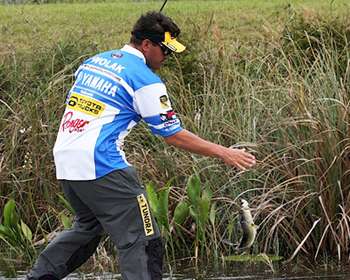
The flick shake technique burst on the professional bass fishing scene several years ago and many Elite Series pros, including Dave Wolak, have since been using this hybrid finesse tactic to add critical weight to the livewell.
For Wolak, the flick shake is a new twist on an old standby — the weightless wacky worm.
"One of the first bass tournaments I ever entered I took third place throwing a wacky worm, so I've been using it for years," he says.
The North Carolina pro adds that the weightless wacky worm is particularly effective early in the year, especially during and after the spawn.
"The bass are usually looking up, either feeding on baitfish or protecting fry, so a bait that stays high in the water column is the most effective," Wolak explains.
So when does Wolak add a little weight to his wacky rig and turn it into a flick shake?
He will most often reach for the flick shake when faced with deep, clear water situations like during the 2009 Elite Series stop on Lake Amistad.
"With a weightless wacky worm, it looks ridiculous in really clear water because it only sinks around 6 inches," he explains. "The flick shake (jighead) gives the worm that slow fall through the upper half and into the middle of the water column."
It all comes down to efficiency and time management. Rather than wait for a weightless offering to reach the strike zone, Wolak is able to get his worm past unproductive water and into the strike zone much more quickly.
The North Carolina pro prefers to fish the flick shake around isolated cover.
"I've seen it work a lot of times around submerged bushes in 6 to 8 feet of water," he explains. "The bass will suspend in the bushes, and the flick shake gets down there faster and still allows for a finesse approach."
Wolak also utilizes the technique when fishing floating docks where the dock platforms extend 2 feet or more under the water. The weighted head allows the bait to quickly fall past the lip of the platform and virtually suspend in the strike zone.
While isolated cover is his preferred target, he has had success fishing the flick shake on pea gravel points where most other anglers opt for a shaky head.
"I'll usually start out with typical power fishing baits and then, after I've beat up on the school, I'll pick up the flick shake and score a few extra bites by shaking it on the bottom," he says.
Wolak usually opts for a 3/32-ounce jighead, claiming that it's the most versatile weight for the majority of applications. When fishing in ultraclear water, he adorns the hook with a 4 3/4-inch Yum Houdini Worm. In stained water, he beefs up the offering by selecting a Yum Dinger soft stickbait.
"It seems that in stained water bass usually want the bigger profile. If the bass are shallow on Kentucky Lake or Grand Lake, you never have a gin clear situation, so the Dinger gets the job done," he explains.
The flick shake may not be Wolak's go-to offering in many situations, but under certain circumstances it has the potential to save the day.
"I try not to fish slowly in tournaments because I like to look for aggressive schools of bass," he says. "However, if I'm stuck in one area or need one more bite, it does work."




